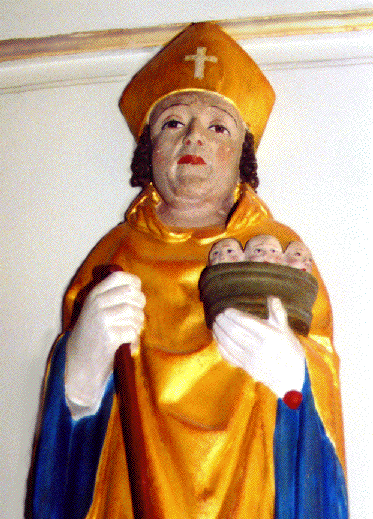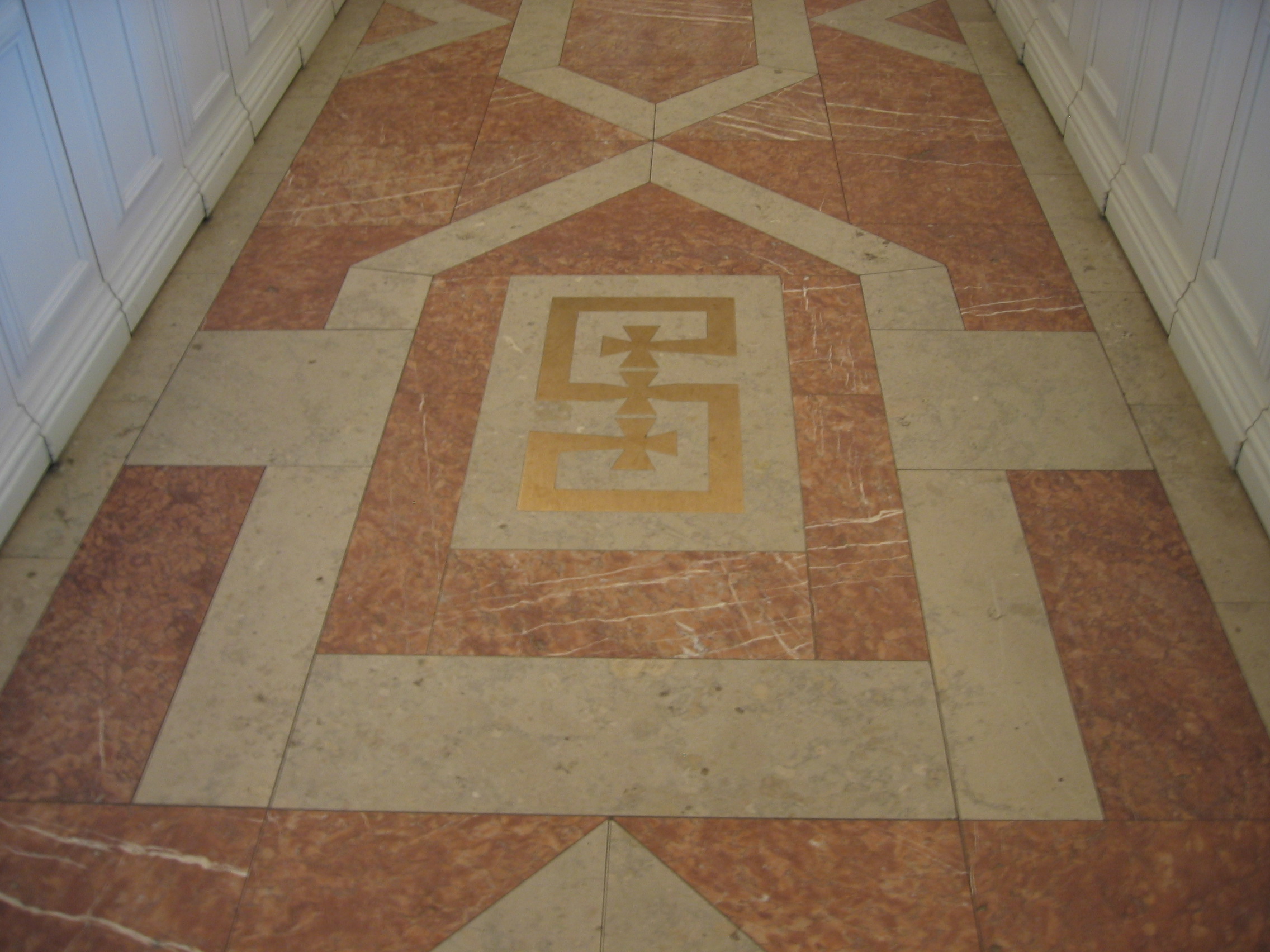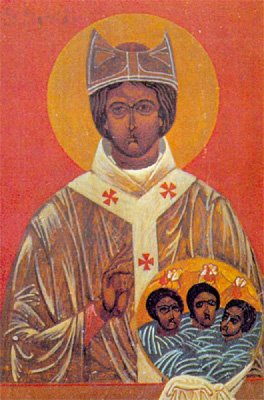Saint Siegfrid
Bénédictin originaire de
la région d'York en Angleterre (+ 1045)
Il fut invité par le roi Olaf de Norvège à évangéliser à nouveau la Suède redevenue païenne après l'évangélisation de saint Anschaire. Le pape Adrien IV le canonisa.
À Wexiow en Suède, vers 1045, saint Sigfrid, évêque, qui partit d’Angleterre,
annonça avec zèle l’Évangile aux peuples du Gotland et baptisa dans le Christ
le roi Olav lui-même.
Martyrologe romain
SOURCE : http://nominis.cef.fr/contenus/saint/5760/Saint-Siegfrid.html
St. Sigfrid (died 1045), English-born
Swedish evangelist and saint. Statue by Peter
Linde outside Växjö cathedral.
Also
known as
Apostle of Sweden
Sigfrid of Vaexjoe
Sigfrid of Växjö
Sigfrid of Wexlow
Sigfried…
Siegfried…
Profile
Priest at York and/or Glastonbury in England. Monk. Evangelized in Norway, Sweden, Denmark.
Brought King Olaf
of Sweden to
the faith.
While Sigfrid was away on a mission, his three nephews (Saint Winaman, Saint Unaman,
and Saint Sunaman),
who had come to help with the work in Sweden,
were beheaded by pagan raiders.
Sigfrid returned, recovered their heads, and claimed they could talk, a claim
that terrorized the pagans. King Olaf
decided to execute the murderers, but Sigfrid spoke against capital punishment
and the killers were spared. Olaf then ordered them to pay a large fine, but
Sigfrid refused the blood money, and thus achieved such a moral high ground
that his mission work
became even more successful.
Born
at Glastonbury, England
one of three bishops on
a ship
bishop menaced
by devils
bishop carrying
three severed heads
bishop carrying
three loaves of bread (misrepresentation
of the heads)
Additional
Information
Book
of Saints, by the Monks of
Ramsgate
Lives
of the Saints, by Father Alban
Butler
Saints
of the Day, by Katherine Rabenstein
books
Our Sunday Visitor’s Encyclopedia of Saints
Patron Saints and Their Feast Days, by the Australian Catholic
Truth Society
Saints
and Their Attributes, by Helen Roeder
other
sites in english
images
sitios
en español
Martirologio Romano, 2001 edición
fonti
in italiano
spletne
strani v slovenšcini
MLA
Citation
“Saint Sigfrid of
Sweden“. CatholicSaints.Info. 28 February 2024. Web. 2 February 2025.
<https://catholicsaints.info/saint-sigfrid-of-sweden/>
SOURCE : https://catholicsaints.info/saint-sigfrid-of-sweden/
San
Sigfrido sulla facciata della Cattedrale di Nidaros, Norvegia
Book of Saints – Sigfrid – 15 February
(Saint) Bishop (February 15) (11th century) An English missionary in Sweden and Norway, favoured by the Christian King Olaf of Norway. He was the instrument chosen by Divine Providence for the conversion of the similarly named King Olaf of Sweden. Saint Sigfrid, made Bishop of Wexiow, at length rested from his long life of toil, and his remains were enshrined in his Cathedral. Some writers say that he was canonised by Pope Hadrian IV; but his name does not occur in the Roman Martyrology.
MLA Citation
Monks of Ramsgate. “Sigfrid”. Book of Saints, 1921. CatholicSaints.Info. 8 February 2017. Web. 3 February 2025. <https://catholicsaints.info/book-of-saints-sigfrid-15-february/>
SOURCE : https://catholicsaints.info/book-of-saints-sigfrid-15-february/
Brass
signature of martyrs Unaman, Sunaman, Vinaman. Stone marker in the crossing in Växjö Cathedral, marking what may be the burial
place of Sigfrid
Sigfrid of Wexlow, OSB B (AC)
(also known as Sigfrid
Växjö)
Born in Glastonbury, England
(?); died at Växjö, Sweden, c. 1045; canonized by Pope Adrian IV (?).
Untrustworthy accounts
say that the patron saint of Sweden is an Englishman, Sigfrid, who reached
Sweden as a result of a call from King Olaf Tryggvason of Norway, who had been
converted himself by another Englishman, Saint Alphege. Sigfrid is said to have
been born in Northumberland, become a priest at York or Glastonbury, and was
sent by King Ethelred as a missionary to Norway with two other bishops, Grimkel
and John.
They labored under the
protection of the archbishop of Bremen (Germany). After converting many pagans,
Sigfrid continued on to Sweden in 1008. Saint Ansgar had planted the seeds of
faith in Sweden in 830; but the country had relapsed into paganism soon after
his time. A second wave of missionary saints, including Sigfrid, followed about
two centuries later.
There he built himself a
wooden church at Växjö in southern Sweden, and labored with success in the
Smaeland and Västergötland districts. He converted twelve of the principal men
of the province, then many others followed their example. The fountain near the
mountain of Ostrabo, since called Wexlow) in which Sigfrid baptized the
catechumens, long retained the names of the first 12 converts, engraved on a
monument.
Others, including the
King Saint Olaf Skotkonung of Sweden, were attracted out of curiosity to see
the rich fabrics and beautiful vessels used during the celebration of the Mass,
to hear his preaching, and to observe the dignity and majesty of the Christian
worship. That attracted them first. But it was the example of the lives of
Sigfrid and his companion missionaries that open their eyes of faith and led to
the baptism of so many others including the king, who was baptized at Husaby
(one of the sites in Sigrid Undset's Kristin Lavransdatter) in a spring that
later bore Sigfrid's name and was the channel of many miracles.
Sigfrid ordained and
consecrated two native bishops to govern neighboring territories, but he
retained the episcopacy of Växjö while he lived. His three nephews--Unaman, a
priest; Sunaman, a deacon; and Winaman, a subdeacon--were his chief assistants
in his apostolic efforts.
Sigfrid also labored in
Denmark. During one of Sigfrid's absences from Sweden, he instructed his three
nephews to carry on the missionary work. A troop of idolatrous rebels--perhaps
out of hatred for Christianity, perhaps in search of booty--plundered the
church of Växjö and barbarously murdered Sigfrid's nephews by cutting off their
heads, putting them in a box, and flinging them into a lake. The bodies they
buried in the midst of the forest where they were never found.
Sigfrid returned,
recovered the three heads and claimed that they could still talk. He asked
whether the crime would be avenged. "Yes," replied the first head.
"When?" asked the second. "In the third generation,"
answered the third. And so it was. The saint had brilliantly used the dead
heads to terrorize his living enemies. Their heads were placed in a shrine. The
king was angered by their deaths and resolved to execute the murderers, but at
Sigfrid's earnest entreaties Olaf spared their lives--an early testimony
against capital punishment. Olaf compelled the guilty to pay a heavy fine to
Sigfrid, but the saint refused to accept it even though he was living in
extreme poverty and had to contend with rebuilding his church. Thenceforth, he
was invincible.
The saint became so
renowned that the Germans claimed him as their own, insisting that he had been
born either in Bremen or Hamburg. He died in old age, and his bones rest
beneath the high altar of the cathedral of Växjö, and were famous for miracles.
Sigfrid was so successful that he is called the Apostle of Sweden, where he is
still venerated. A metrical office for his feast survives in both Sweden and
Denmark.
He is reported to have
been canonized by Pope Adrian IV, but there is no proof it (Attwater, Benedictines,
Bentley, Delaney, Farmer, Husenbeth, Walsh).
Saint Sigfrid is pictured
as a bishop with two companion monks crossing the sea in a ship. He may also be
shown baptizing King Olaf of Sweden, or menaced by devils. There is a 14th
century wall-painting possibly of him at Stoke Orchard, Worcestershire
(Roeder). He may also be represented as a bishop carrying the heads of his
three nephews, which are sometimes misrepresented as three loaves (Farmer).
SOURCE : http://www.saintpatrickdc.org/ss/0215.shtml
Sankt
Sigfrids kyrka. Sankt Sigfrid,skuptur tillverkad av konstnärinnan Eva Spångberg
1979.
Sigfrid with the heads of his martyred nephews Sankt Sigfrid Church, near Nybro. Sankt Sigfrid, sculpture made by artist Eva Spångberg 1979.
February 15
St. Sigefride, or Sigfrid, Bishop,
Apostle of Sweden
From Joan. Magnus, Hist. Goth. l. 17.
c. 20. quoted by Bollandus, and chiefly from a life of this saint, compiled at
Wexiow about the year 1205, published from an ancient MS. by the care of Ericus
Benzelius, junior, in his Monumenta Historica vetera Ecclesiæ Suevogothicæ,
printed at Upsal in 1709, p. 1. ad p. 14. and in Prolegom. sect. 1. The editor
was not able to discover the author’s name: upon which he repeats the remark of
the learned Maussac (in Diss. Critica ad Harpocrat.) that “many monkish writers
endeavoured to conceal their names out of humility.” On which see Mabillon,
Diar. Ital. p. 36. Benzelius gives us a considerable fragment of a second life
of this holy prelate, ib. p. 21. ad 29. and some verses of Bishop Brynoth the
third, on St. Sigfrid and the other bishops of this province, ib. p. 72.
OUR zealous ancestors having
received the light of faith, propagated the same throughout all the northern
provinces of Europe. St. Anscarius had planted the faith in Sweden, in 830; but
it relapsed soon after into idolatry. King Olas Scobcong entreated King Edred,
who died in 951, to send him missionaries to preach the gospel in this country.
Sigefride, an eminent priest of York, undertook that mission, and on the 21st
of June, in 950, arrived at Wexiow, in Gothland, in the territory of Smaland.
He first erected a cross, then built a church of wood, celebrated the divine
mysteries, and preached to the people. Twelve principal men of the province
were converted by him, and one who died, was buried after the Christian manner,
and a cross placed upon his grave. So great numbers were in a short time
brought to the faith, that the cross of Christ was triumphantly planted in all
the twelve tribes into which the inhabitants of South-Gothland were divided.
The fountain near the mountain of Ostrabo, since called Wexiow, in which St.
Sigefride baptised the catechumens, long retained the names of the twelve first
converts, engraved on a monument. King Olas was much pleased with the accounts
he heard of the man of God, and many flocked from remote parts, out of mere
curiosity to hear his doctrine, and to see him minister at the altar, admiring
the rich ornaments of linen, and over them of silk, which he wore in
celebrating the divine mysteries, with a mitre on his head, and a crosier, or
pastoral staff in his hands. Also the gold and silver vessels which he had
brought with him for the use of the altar, and the dignity and majesty of the
ceremonies of the Christian worship, attracted their attention. But the sublime
truths of our religion, and the mortification, disinterestedness, zeal, and
sanctity of the apostolic missionaries, engaged them to give them a favourable
reception, and to open their eyes to the evidence of the divine revelation. St.
Sigefride ordained two bishops, the one of East, the other of West Gothland, or
Lingkoping, and Scara. The see of Wexiow he continued himself to govern so long
as he lived. His three nephews, Unaman a priest, and Sunaman and Wiaman, the
one a deacon, the other a subdeacon, were his chief assistants in his apostolic
labours. Having intrusted the administration of his see of Wexiow to Unaman,
and left his two brothers to assist and comfort him, the saint himself set out
to carry the light of the gospel into the midland and northern provinces. King
Olas received him with great respect, and was baptized by him, with his whole
court and his army. St. Sigefride founded many churches, and consecrated a
bishop of Upsal, and another of Strengues. The former of these sees had been
founded by St. Anscharius in 830, and the bishop was declared by Pope Alexander
III. in 1160, metropolitan and primate of the whole kingdom. During the absence
of our saint, a troop of idolatrous rebels, partly out of hatred of the
Christian religion, and partly for booty, plundered the church of Wexiow, and
barbarously murdered the holy pastor Unaman and his two brothers. Their bodies
they buried in the midst of a forest, where they had always remained hid. But
the murderers put the heads of the martyrs into a box, which, with a great
stone they had fastened to it, they threw into a great pond. But they were
afterwards taken out, and kept richly enshrined in the church of Wexiow till
their relics were removed by the Lutherans. These three holy martyrs were
honoured in Sweden. Upon the news of this massacre St. Sigefride hastened to
Wexiow to repair the ruins of his church. The king resolved to put the
murderers to death; but Sigefride, by his earnest entreaties, prevailed on him
to spare their lives. However, he condemned them to pay a heavy fine, which he
would have bestowed on the saint, but he refused to accept a single farthing of
it notwithstanding his extreme poverty, and the difficulties which he had to
struggle with, in laying the foundation of that new church. He had inherited
the spirit of the apostles in an heroic degree. Our saint died about the year
1002, and was buried in his cathedral at Wexiow, where his tomb became famous
for miracles. He was canonized about the year 1158, by Pope Adrian IV., 1 an
Englishman, who had himself laboured zealously, and with great success, in the
conversion of Norway, and other northern countries, about a hundred and forty
years after St. Sigefride, who was honoured by the Swedes as their apostle,
till the change of religion among them. 2
Note 1. Vastove, Vinea Aquilonis. [back]
Note
2. In the life of St. Sigefride, published by
Benzelius, it is mentioned, that St. Sigefride, upon his first arrival in
Sweden, preached chiefly by interpreters. [back]
Rev. Alban Butler
(1711–73). Volume I: January. The Lives of the Saints. 1866.
St.
Sigfrid, Bishop Växjö and Second Apostle of the North
San Sigfrido di
Vaxjo Vescovo
Festa: 15 febbraio
Inghilterra sec. X –
Växjö (Svezia), 1030
Era un vescovo
missionario originario dell'Inghilterra da cui si spostò intorno al 995 prima
in Norvegia e poi in Svezia. Vi sarebbe giunto attraverso la Danimarca
fermandosi a Värend, dove avrebbe costruito una chiesa. Secondo quanto riferito
da antiche tradizioni locali avrebbe affidato la gestione della sua piccola
comunità a tre compagni missionari per recarsi presso la fonte di Husaby dove
avrebbe battezzato il re Olav Skötkonung. Al suo ritorno a Värend trovò che i
suoi compagni erano stati decapitati. Sigfrido sarebbe stato il primo vescovo
di Skara, nelle regione del Gotland e per la sua attività missionaria nel Paese
scandinavo è soprannominato «apostolo della Svezia». Morì a Växjo intorno al
1030. Il suo culto è particolarmente diffuso in Svezia, Norvegia, Finlandia e
Danimarca fin dal XIII secolo. Sue reliquie si trovano a Copenaghen e Roskilde. (Avvenire)
Etimologia: Sigfrido
= con la vittoria dà pace, dal tedesco
Emblema: Bastone
pastorale
Martirologio
Romano: A Växjö in Svezia, san Siffredo, vescovo: di origine inglese,
evangelizzò le genti di questa regione con grandissimo zelo e battezzò in Cristo
lo stesso re Olaf.
Fa parte di quella schiera di missionari cristiani, che dalla cattolicissima Inghilterra dell’epoca, partirono per evangelizzare i popoli dell’Europa Settentrionale.
Sigfrid appunto era un vescovo missionario inglese, che predicò in Svezia al tempo del re Olav († 1024), secondo una leggenda scritta nel 1205, egli giunse a Värend attraverso la Danimarca, dove professò la religione cristiana, costruendo anche una chiesa.
Lasciò Värend a tre compagni missionari e si recò a battezzare il re Olav Kötkonung, cerimonia che avvenne presso la fonte di Husaby, secondo quanto raccontano le più antiche leggende dei re svedesi.
Quando ritornò a Värend, trovò che i suoi tre compagni erano stati decapitati. Altro non si sa; secondo la storia dei vescovi locali, Sigfrido è il primo vescovo di Skara, ma ponendo comunque il suo apostolato a Växjö, dove poi morì intorno al 1030.
La sua festa ricorre il 15 febbraio. Il culto è stato molto diffuso in Svezia, almeno fino all’avvento del protestantesimo; lo Smäland è la regione con il maggior numero di suoi ricordi, vicino ad Husaby vi sono due fonti, una di s. Britas e l’altra di s. Sigfrid e nella locale chiesa vi è una statua che lo raffigura in abiti vescovili e con in mano un bacile, dove sono poggiate le tre teste dei compagni uccisi.
Växjö è comunque il centro del culto tributatogli e in molte chiese della regione vi sono sculture lignee di Sigfrid, che generalmente sono del tardo Medioevo.
Autore: Antonio Borrelli




